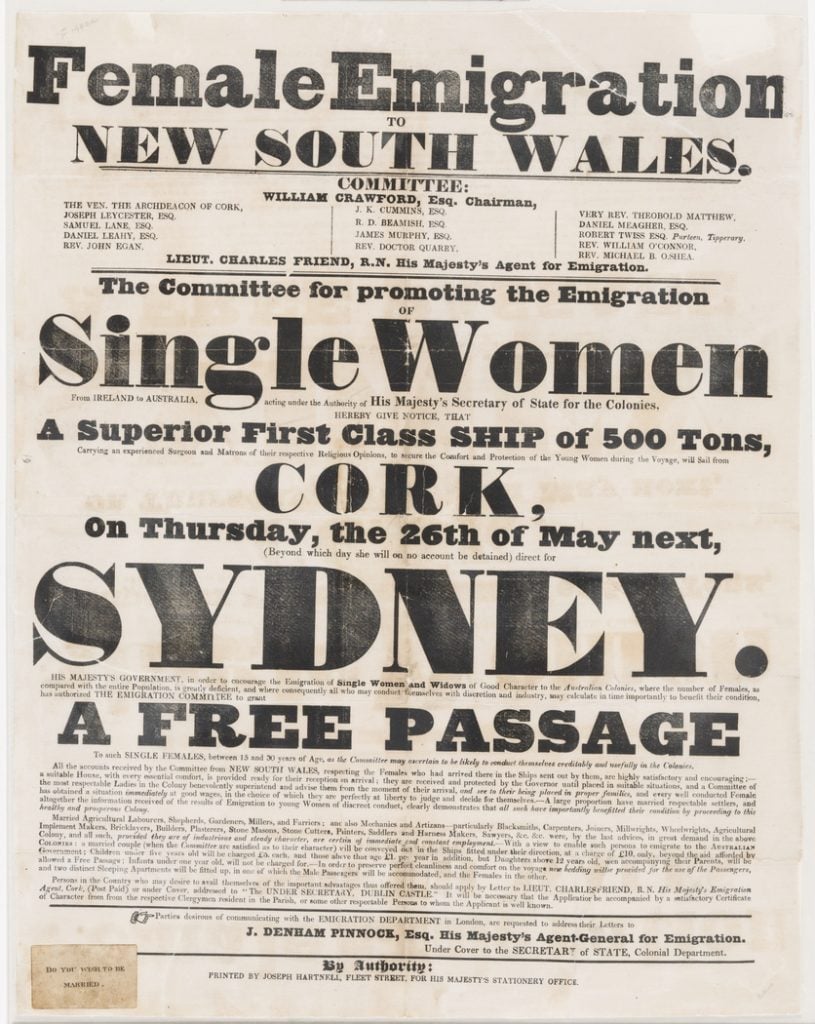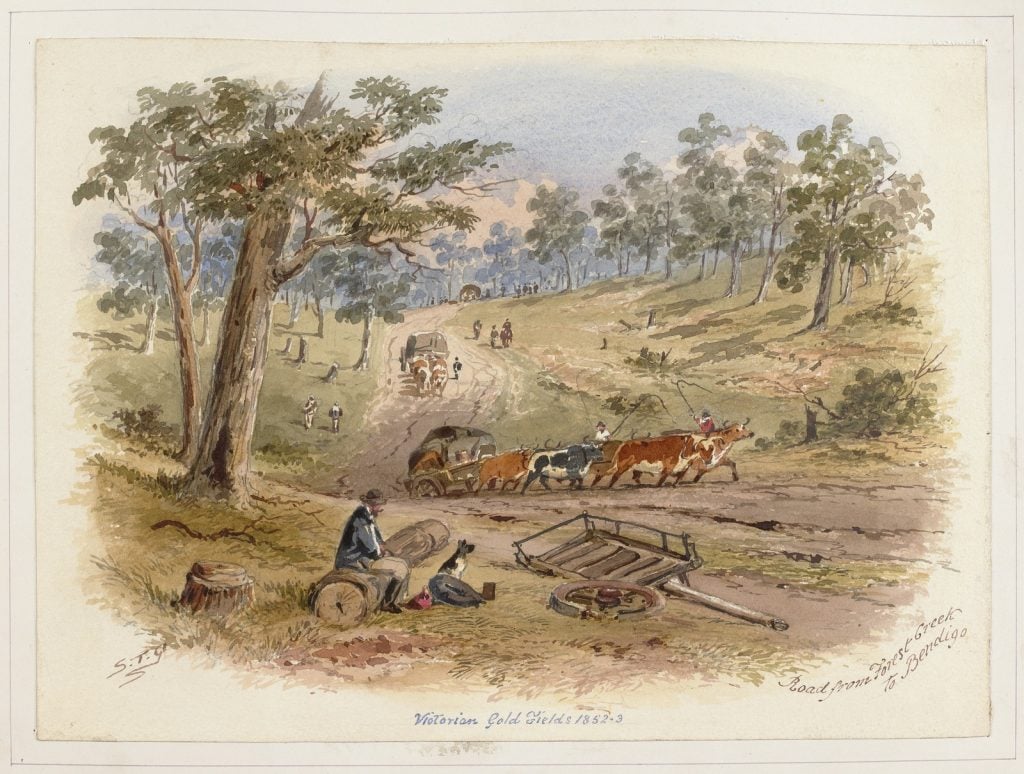…tall, embonpoint, and stately in her bearing: frank, easy, and ladylike in her manners; her mouth shows her determination of character; her eyes are grey, penetrating in their glance; and her countenance beaming with kindness, which at once causes confidence in her intentions; a certain calmness and earnestness rest on her features which are aroused into powerful expression as the subject of her discourse is advice, affection, or contempt; her voice is musical, without the slightest provincialism; she speaks with fluency and appropriateness of phraseology; and as occasion calls forth can be affecting, sarcastic, or witty. 1
The woman in question was Caroline Chisholm. She was the friend, the safe person to turn to when things were not quite right for the many immigrants who came to Australia to change their luck and build a better life.
“Advance Australia” Caroline Chisholm, 1852. Painted by A C Hayter; H15493
Caroline arrived in Sydney, Australia for the first time in September 1838 accompanied by her husband, Captain Chisholm, and their two young sons. What she found there was troubling. At the time there were two systems of immigration: the Government System and the Bounty System. The latter was so-called because the Government paid a ‘bounty’ to certain persons for every immigrant within a certain standard whom they landed in Australia. This paved the way for abuse:
Bounty agents were paid to travel through the UK urging people to emigrate. Life in the colonies was painted in glowing colours by these agents, whose sole object was to induce large numbers to emigrate, regardless of their suitability, or their likelihood of adapting themselves to colonial conditions. 2
So, upon arriving to Australia these people learnt that there were no provisions put in place to receive them or to give them information. They were strangers in a strange land. The saddest thing of all was the large numbers of girls who left their homes in search for that glowing life painted by the agents. This meant that by the 1840s there were hundreds of girls and young women – homeless – wandering the streets of Sydney.
Ireland. Female emigration to N.S.W. from Ireland. Ship to sail from Cork, a6087008 / D 356/17/8. Courtesy of Mitchell Library, State Library of New South Wales
Once Caroline understood the situation, she immediately started to act to fix this horrible state of affairs, working tirelessly towards helping and guiding the immigrants. She found positions for immigrant girls and sheltered many of them in her home. In January 1841 she approached the Governor and Lady Gipps and the proprietors of the Sydney Herald, and others, with a plan for a girls’ home. Many of her letters can be read online via the State Library Victoria catalogue.
Her next concern was to disperse the unemployed into the country. Caroline sent out hundreds of circulars, franked by Governor Gipps, to small farmers, police magistrates, clergymen and other people of influence to ask them about demand for labour in their country communities. Before too long, thanks to Caroline’s efforts, resting stages and employment agencies could be found in a dozen rural centres. 3 She was a breath of fresh air for so many, and probably the only chance at a decent life for most of those poor young girls.
In 1846 she sailed back to England. Here she fought to get help for the wives and children of immigrants or convicts still serving their punishment in Australia, to bring them to Australia and reunite their families. She was a strong believer that families needed to stay together. This was the only way in which a society would move forward. She was herself a devoted wife and mother. Also, while in England her house became an ‘Australian information centre’, for some years receiving an average of 140 letters a day! 4
She returned to Australia in 1854 – this time to Victoria which was now a separate colony and no longer a district of New South Wales. She wanted to visit the goldfields, to see how people lived and what the conditions were. She’d heard many stories, not all positive, and she was agreeably surprised to find ‘such a fine body of intellectual men’5 on the fields. But again, she was concerned by the fact that most diggers had wives and children back home and the cost of bringing them over was out of reach for most of them. It was also very difficult for them to secure land on which they could settle with their families. But the biggest obstacle in bringing their families over was the awful conditions which prevailed on the roads. These conditions increased the diggers’ expenses and difficulties, especially because of the lack of accommodation.
Queens Wharf, Melbourne, West End, in the “Fifties”; H8819
Caroline considered that the lack of accommodation could be fixed by establishing second-class hotels at several points along the way to the diggings. First route: Forest Creek, as she considered those to be the best diggings.
The sheds were to be built a day’s march from each other at Essendon, Upper Keilor, Aitkin’s Gap, Gisborne, the Black Forest (2 sheds), Woodend, Carlsruhe, Kyneton, Malmesbury, Taradale, Elphinstone, Castlemaine, Muckleford Creek, and Maldon.6
Road from Forest Creek to Bendigo. Watercolour painting by S.T.Gill; H86.7/21
If the plan succeeded on the Castlemaine route it was to be extended to the other goldfield routes. A portion of the Immigrants’ Rate Fund was to be spent for the erection of these sheds, but the total cost limited to £3,800. In the end, the plan was modified, and the sheds that were built were at Essendon, The Gap, Gisborne, Keilor, Keilor Plains, the Black Forest, Woodend, Carlsruhe, Malmesbury and Elphinstone. 7 Caroline Chisholm was to manage the society which organised the shelters. By November 1855 the shelters were ready for reception. The shelters were a success, enduring for another 50 years, but no others were built, probably because Caroline felt that she was not up to the task as her health was failing.8
Caroline Chisholm was a caring person who loved her fellows, and that love was constantly expressed by practical common-sense actions. Wherever she lived she left a trail of good deeds behind. She changed lives, she saved lives. She gave hope and a chance to a new beginning to so many.
Her efforts made a great difference to the way Australia was receiving and caring for its newest citizens: the immigrants. Her work led to bills and laws being passed and changed so that people from all over the world would be able to settle here and build better lives.
References
- Swann, Margaret, 1925, Caroline Chisholm, the Immigrants’ Friend, A J Kent, Govt Printer, Sydney, p 5
- As above, p 3
- Iltis, Judith, 1966, ‘Chisholm, Caroline (1808–1877)‘, Australian Dictionary of Biography, viewed 23 March 2024
- As above
- Argus, 11 November 1854, p 5
- Kiddle, Margaret, 1990, Caroline Chisholm; with an introduction by Patricia Grimshaw. Abridged ed., reproduced with new introduction, Melbourne University Press, Carlton, Vic, p 166
- As above, p 167
- As above, p 168






I had to look up the Australian Dictionary of Biography for the missing sentence in your introduction- she was a farmer’s daughter from Northampton.
Hi Alexander, yes indeed she was from Northampton, England. Thank you.
Hi Ana Maria
Very interesting to be reminded of the amazing person Caroline was.
I have an interest in her efforts to bring children of Irish Immigrants(left at home when parents immigrated due to cost) to join their families in NSW and Victoria
She organised the search in Ireland and subsequent 3mnth voyage
In 1848 a number of children came of Melbourne and Sydney on the ship Sir Edward Parry
The voyage was advertised a yr or so before, and parents had to apply for the reunion,
then collect their children on arrival
I wonder if any of the corrspondence relating to this journey still exists.???
Ellen King aged 9 yrs joined her parents ,who had arrived in Melbourne 1841, and were farmers near Wangaratta
Hi Julie, we do have some of her correspondence here at State Library Victoria. Most of it had been digitised and can be read online via our catalogue
Caroline Chisolm is one of my Australian pioneering heroines. Several years ago, I was researching my 3-times Great Grandparents in Lord Monteagle’s estate records at the National Library of Ireland in Dublin. I was delighted when a signature on one document jumped it out at me. It was Caroline Chisolm. Have seen it on the $5 note for decades since I was a child, I recognised the distinctive handwriting immediately. Although I didn’t find what I was looking for in the records, it was a special moment seeing and reading the great Ms Chisolm’s correspondence with Lord Monteagle about Irish immigration to Australia.
Hi Therese, that is a great story, thank you for sharing.
Fascinating story about a very caring and courageous woman, thank you for sharing it!
Hi Robyn, I am very glad you like it. Thank you.
Hi Ana-Maria
Thank you for that insight into Caroline Chisholm. I remember learning about her in Primary School in the 50’s and was so amazed at her far reaching work. Your article has renewed my interest and I am now anxious to learn more about this fascinating, intelligent and caring women.
Hi Dawn,
I am glad you like it. Indeed, she was an amazing woman so devoted in helping others. Very inspirational.